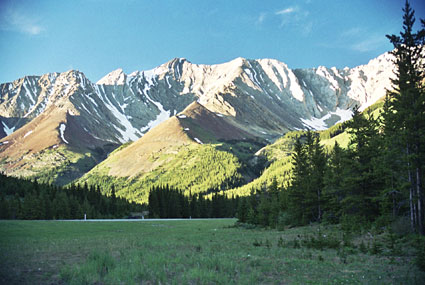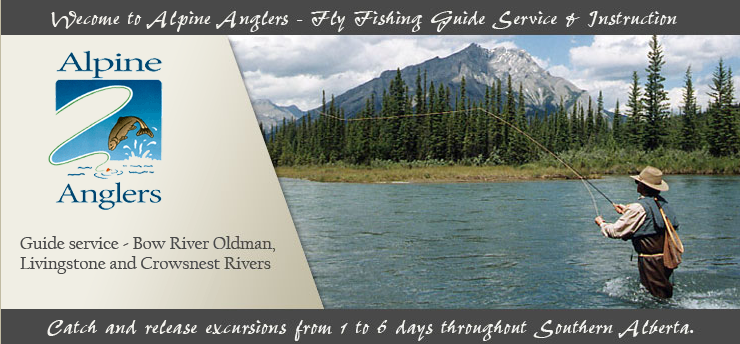Don Reilly : Alpine Anglers
They call the Banff Springs Hotel the jewel of the rockies. Hah, little do ‘they’ know.
The real gem, as far as anglers are concerned, is the Bow River, which gets its start from the glaciers at Bow Lake, a short distance north of Lake Louise. Milky turquoise waters, the result of the suspended particulate matter, meander south and east past Lake Louise, Banff, Canmore, Cochrane, through Calgary, toward Medicine Hat, and onwards to Hudson Bay.
From the headwaters to just east of Exshaw, the Bow flows past the base of mountain peaks which provide a spectacular back drop, Castle Mountain, the Sawback range, the Three Sisters, and Heart Mountain to name only a few.
Flowing within Banff National Park for the first 100 or so kilometers, the River displays many characters, from fast and tumbling, to slow, deep and quiet and everything in between. The upper section, from Bow Lake to Lake Louise, is largely the former as it descends from its source above 6350 feet elevation to the main river valley.
Rocky mountain whitefish and cutthroat trout, along with a few remnant bull trout are the main residents. I have also heard stories of the occasional lake trout caught near Lake Louise.
From Lake Louise to Castle Junction the river is largely a wide, shallow, freestone stream averaging less than 3 feet in depth. Relatively little good holding water necessitates a willingness to walk some distance to access productive water. Rocky mountain whitefish and brookies predominate here, with an increasing number of bull trout as well, thanks, partly, to recent regulation changes requiring the release of all bull trout within Banff National Park.
From Castle Junction to Banff the gradient decreases, giving the river a very different character, with many very slow, deep runs. Access becomes somewhat more difficult as the valley widens, and the river meanders between the CPR rail line and ‘scenic’ Bow Valley Parkway on the north, and the TransCanada highway on the south. Fencing installed along the TransCanada highway, to reduce animal deaths also acts as a barrier to access to the river. There are a few gates, but best access is from the Bow Valley Parkway. Whitefish, and brook trout dominate, with cutthroats, and a few bulls in some sections.
The river within Banff National Park is not really suitable for floating. There are no official launch sites for boats, and canoeing can be very dangerous due to the ever-changing banks, sweepers, and log jams. Anglers are advised to stick to the shores, and wade safely.
The Bow Falls, within the Banff town site, form a natural boundary for the browns which dominate down stream , along with white fish, occasional brookies, and bull trout. The Falls also demarcate a change in character, as flows again pick up speed and volume, with the addition of Spray River. From here to Seebee, the site of the first man made obstruction to the natural rhythms of flow , the river is again a predominantly fast, free stone stream.

Limited access from the Bow Falls to the east park boundary, just west of Canmore, is primarily by way of the Rundle Riverside Trail which follows the river from the Banff Springs Golf course to the Canmore Nordic Centre, home of the nordic events for the 1988 Winter Olympics.
Launch sites in Canmore, Deadman’s Flat, Exshaw and at Seebee, allow canoeing or drifting for seasoned boaters, but the river changes almost daily, and previous experience on this river is strongly recommended.

Dead Mans Flats to Exshaw is a very slow and quiet section, while from Exshaw to Seebee there is a good combination of fast runs, and long, deep slow pools.
The Bow was once the home range to large populations of Alberta’s native bull trout, which is really a char (previously known as dolly varden), and west slope cutthroat trout. Human interactions, habitat destruction, and over harvesting have had serious negative impacts on both of these species. For many years, bull trout were considered a nuisance fish, and was known to have been caught and tossed into the bushes to perish, in efforts to rid the waters of them, in order to allow the preferred rainbows and browns to flourish. The Cutthroat, and stocked rainbows, brookies, and browns were deemed to be ‘better’ and were given elevated status by anglers and fisheries managers. We have seen the errors of our ways recently, and with new attitudes toward things natural, and the introduction of catch and release regulations, both the bull and cutthroat are beginning to make a come back.
Although there has not been a recent population survey, it is believed that Bow River trout number around 300 -500 per kilometer, with more downstream of each municipality adding to the nutrient load, increasing the rivers capacity for the weeds and invertebrates which, in turn, support the fishery.
Techniques:
Well equipped fly fishers come armed with 5 or 6 weight rods, and a variety of lines, floating and intermediate to fast sinking tip lines being of most use. An ability and willingness to alter and adjust techniques will vastly increase an anglers odds. There are times when dry fly action is fast and furious, and times when nothing but an appropriate streamer, well delivered, will produce strikes.
The presence of large numbers of logs protruding from the banks, and river bottom preclude nymphing in most of the upper section of the river. Often, though, this is the most effective technique, but it can get expensive, with many lost flies.
Generally, long fine tippets are not required, as fish in the area are not overly sensitive to angling pressure, although this is changing with more angler-days spent on the river. Leaders in the 6 to 9 foot range tapered to 5x for dry flies, and 4 to 6 foot 3x or 4x for streamers are appropriate.
As with all eastern slopes streams, use of bait, except in certain limited areas, and at very restricted times of year, is not allowed, so spin fishers will have best success with small to medium spoons like red and white, 5 of diamonds, Kamloopers, and Rapallas, and Mepps or Panther Martin spinners in gold, silver, or fire tiger colour schemes.
Fish tend to be found in the same sorts of water as other foothills rivers, with heads of pools, downstream ends of submerged gravel bars, current convergence areas below islands and gravel bars or other structure, and around log jams being preferred holding water. Getting a fly or lure to these hot spots often proves productive.
Hiring a guide to learn each section of the river you want to fish may save you hours of discomfort, frustrated bush whacking, and will give you some local expertise
Seasons:
Angling is permitted on the Bow within Banff National Park year round, so long as the water is flowing openly .There are two legal jurisdictions, Banff National Park, and the province of Alberta each responsible for sections of the river. Separate licenses, seasons, and gear restrictions apply for each jurisdiction. Make sure to read the regulations.
Flows in the Bow are subject to extreme seasonal fluctuations. Late fall, when snow melt has ceased for the year, after the first couple of frosts, and early spring, before the onset of 20oC weather kick starts run off, flows can be as low as 250 cfs (cubic feet per second). Much of the river is too thin to hold any but very small fish so willingness to put in a few miles of walking searching for the deeper, slower water may be required to be successful. April to early May can provide very good fishing on the Bow, depending on weather, and is a time to use nymphs, spinners, or spoons, fished deep and retrieved slowly.
As temperatures rise, flows increase, creating more suitable habitat, fish begin feeding more actively, and begin to spread out from their wintering lies.
Run off normally starts about the May long weekend and continues for, as few as two, to as many as six weeks. Until flows drop below 2000 cfs fishing is pretty much a write off, and it is time to try the local lakes. Johnson, and Minnewanka in the park, and Chief Hector at Nakoda Lodge are the best bets. Both upper and lower Kananaskis and Spray Lakes in Kananaskis Country are also worth checking out for a day or so.
This past year, run off was late and, although flows were up Victoria Day, the real run off didn’t commence until June 15, peaking at 7522 cfs, 30 times the yearly low. Most years peak at about 3500 cfs, for a peak flow increase of 13 times.
About mid June, as flows drop, the medium brown stone fly hatch gets going providing some of the upper Bows best dry fly action, continuing for about six weeks. Shortly after the commencement of these large flies, the western green drakes get going with a vengeance, providing our second most important hatch, and terrific dry fly action.
Most years, the week of the Calgary Stampede is just about prime time. Although the stones are waning, fish having a good memory for these big bugs, and the drakes are in full swing.
There is not a huge caddis fly population, as on the lower Bow or the Crowsnest, but they are still a significant insect, which along with pale morning and/or evening duns and blue winged olives, provide decent dry fly action through to at least mid September.
By mid October the browns have begun migrating to their preferred spawning areas. Bill Giffiths Creek, just east of Canmore, is the most important spawning area in the section from Seebee to Bow Falls, with upwards of 60% of the brown trout population utilizing this 3 kilometer spring creek. Carrot creek in BNP, and sections of some of the channel braids near Bill Griffiths are also heavily used. This section of the Bow is closed to angling October 1.
There is a lot more than just the fishing. Many hours can be idled away watching the local wildlife, including bears, elk, beavers, otters, muskrats, eagles, osprey, kingfishers and lots of water fowl.
Whether for the fishing or not, come, enjoy the Jewel of the Rockies.
